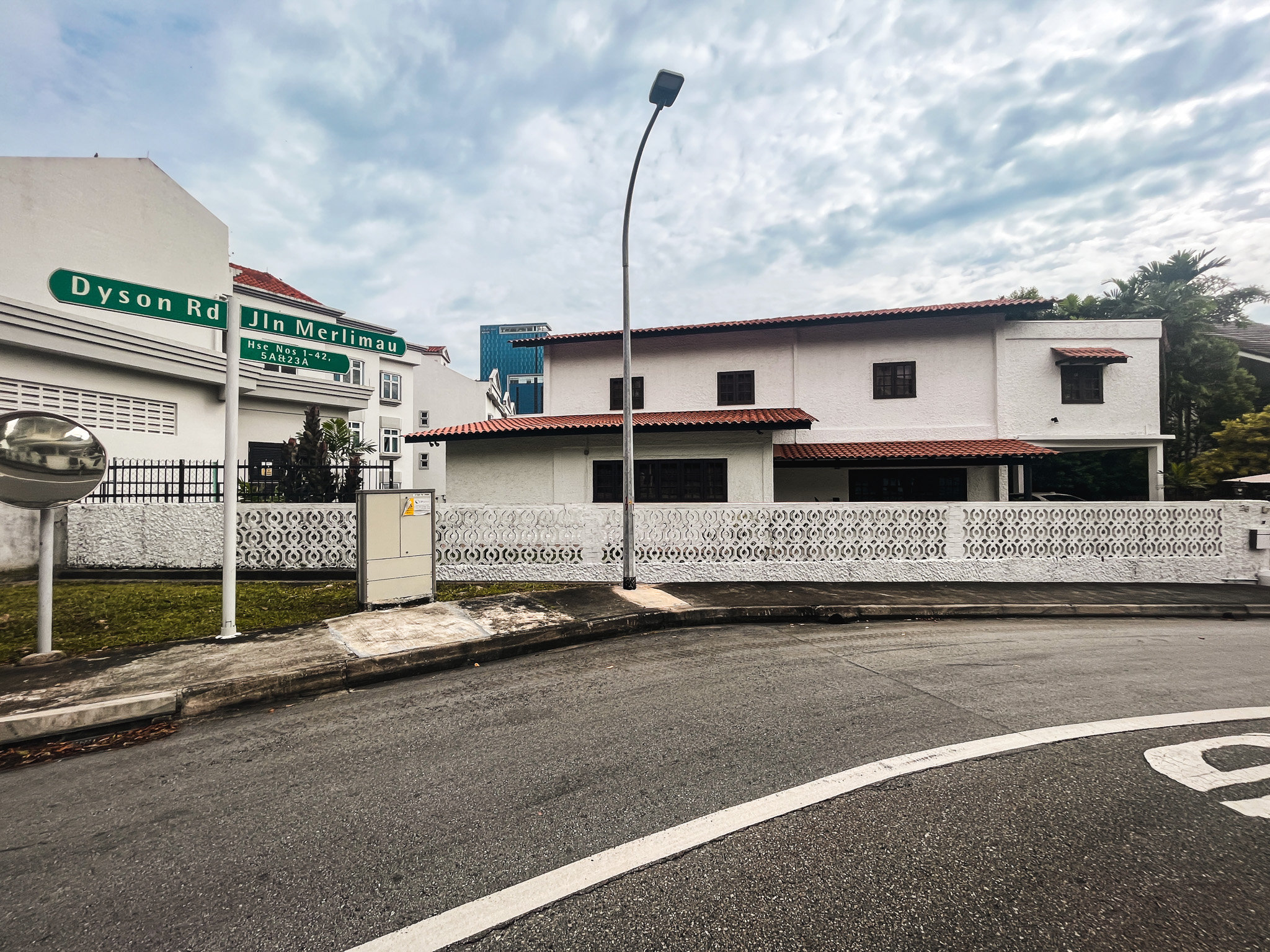The Trivelis DBSS Vs Clementi Ridges Issue 10 Years On: Did Trivelis Owners Really Lose Out?
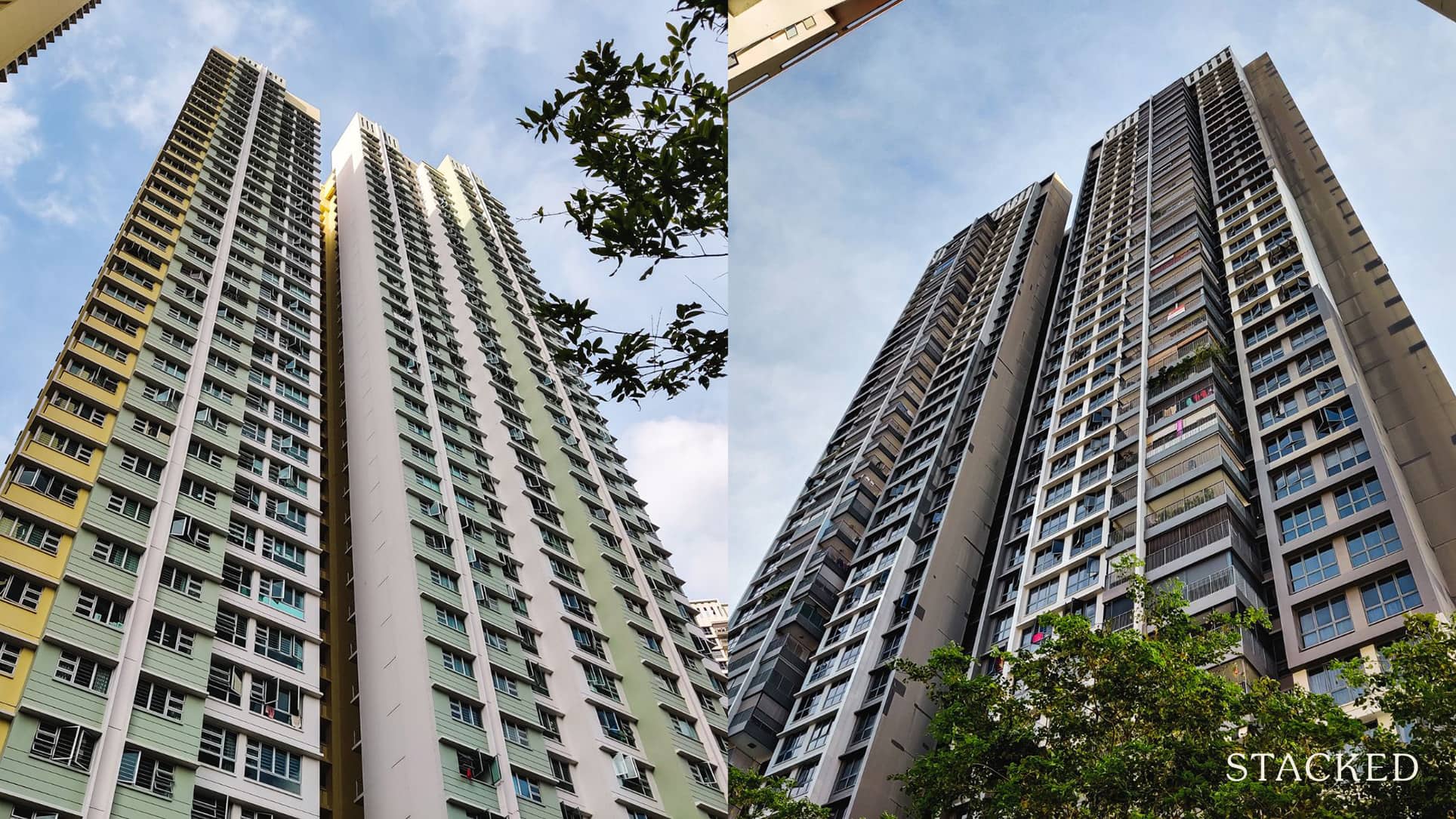
Get The Property Insights Serious Buyers Read First: Join 50,000+ readers who rely on our weekly breakdowns of Singapore’s property market.
A seasoned content strategist with over 17 years in the real estate and financial journalism sectors, Ryan has built a reputation for transforming complex industry jargon into accessible knowledge. With a track record of writing and editing for leading financial platforms and publications, Ryan's expertise has been recognised across various media outlets. His role as a former content editor for 99.co and a co-host for CNA 938's Open House programme underscores his commitment to providing valuable insights into the property market.
Several years ago, the DBSS project Trivelis made the news, but not in a good way. Besides some quality complaints, the biggest issue was due to their newer neighbour next door. Buyers were miffed when a BTO project – Clementi Ridges – launched next door to them.
Probably the most frustrating thing was the timing of it all. Clementi Ridges was announced just 5 months after, and it would be bigger, cheaper, and newer by a year. Views would also be blocked, as Clementi Ridges would be at the same 40-storeys. It was also reported that some even forfeited their Trivelis deposit to try their luck on the Clementi Ridges BTO, such was the appeal.
However, some argued that Trivelis may still have been a good deal, as the quality of DBSS flats would win out. Now, close to a decade after Trivelis was launched, let’s see the outcome by comparing the prices between the two:
The significance of Trivelis vs. Clementi Ridges
The Design, Build, and Sell Scheme (DBSS) was another mid-point between condos and flats. They were designed and built entirely by private developers, but did not have the common facilities associated with full-fledged condos or Executive Condos (ECs). They were also sold under the auspices of HDB, rather than sold directly by developers in show flats.
Due to several complaints involving quality and rising cost (and frankly, it just wasn’t differentiated enough), DBSS was suspended indefinitely in 2012. This is where the story of Trivelis comes in.
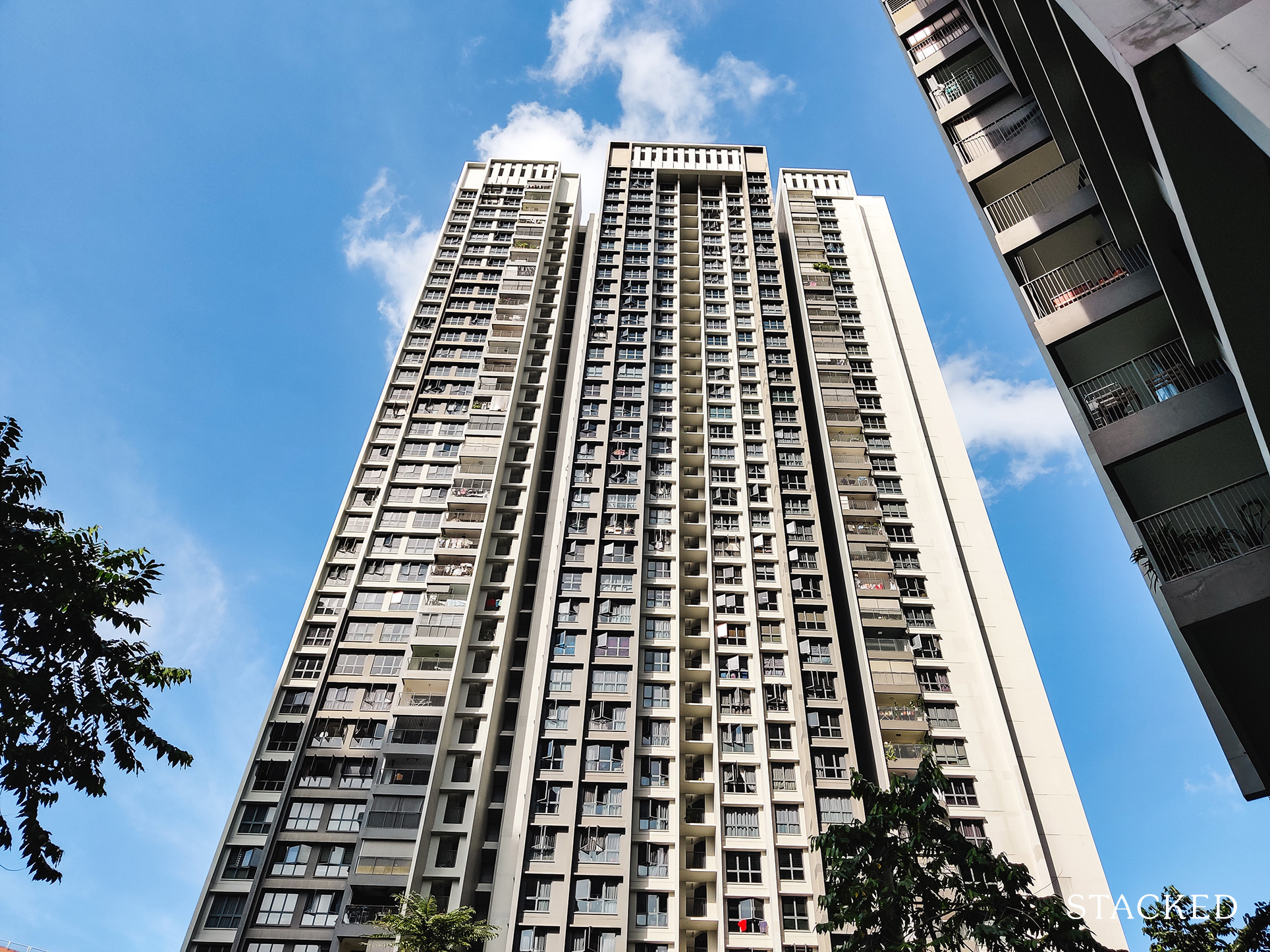
Trivelis was the second-last DBSS project to be launched; and on the ground, there have always been rumours that it was the final nail in the DBSS coffin. Trivelis buyers complained about several defects, but that wasn’t even the biggest issue: their biggest gripe was the launch of a BTO project next door, called Clementi Ridges. As you’ll see below, Clementi Ridges was both significantly cheaper, and yet larger. This caused several Trivelis buyers to cry foul, and feel they’d been short-changed.
Not everyone agreed with this, however. Some felt that DBSS status would mean Trivelis will see higher demand, and win out in gains in the end. Over the course of last year, it was also seen that many of the million-dollar flats were in fact DBSS projects, regardless of earlier complaints over quality.
As we approach 2023, we decided to check on the prices at Trivelis and Clementi Ridges, to see whether the “DBSS effect” has ultimately turned things around:
How have prices moved since launch?
Trivelis and Clementi Ridges were launched less than half a year apart, with Trivelis launching in October 2011, and Clementi Ridges launching in March the next year. Here’s how their prices have moved:
(Do note that CR = Clementi Ridges, TV = Trivelis. It was shortened for ease of viewing).
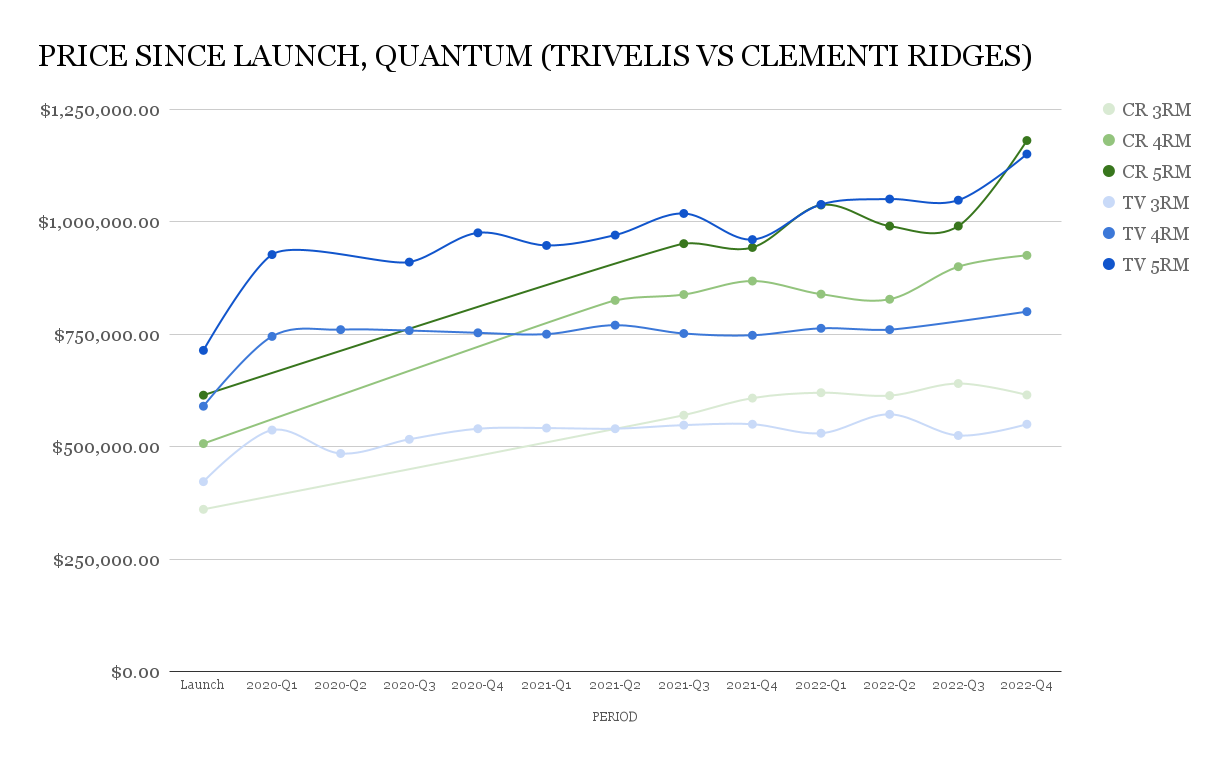
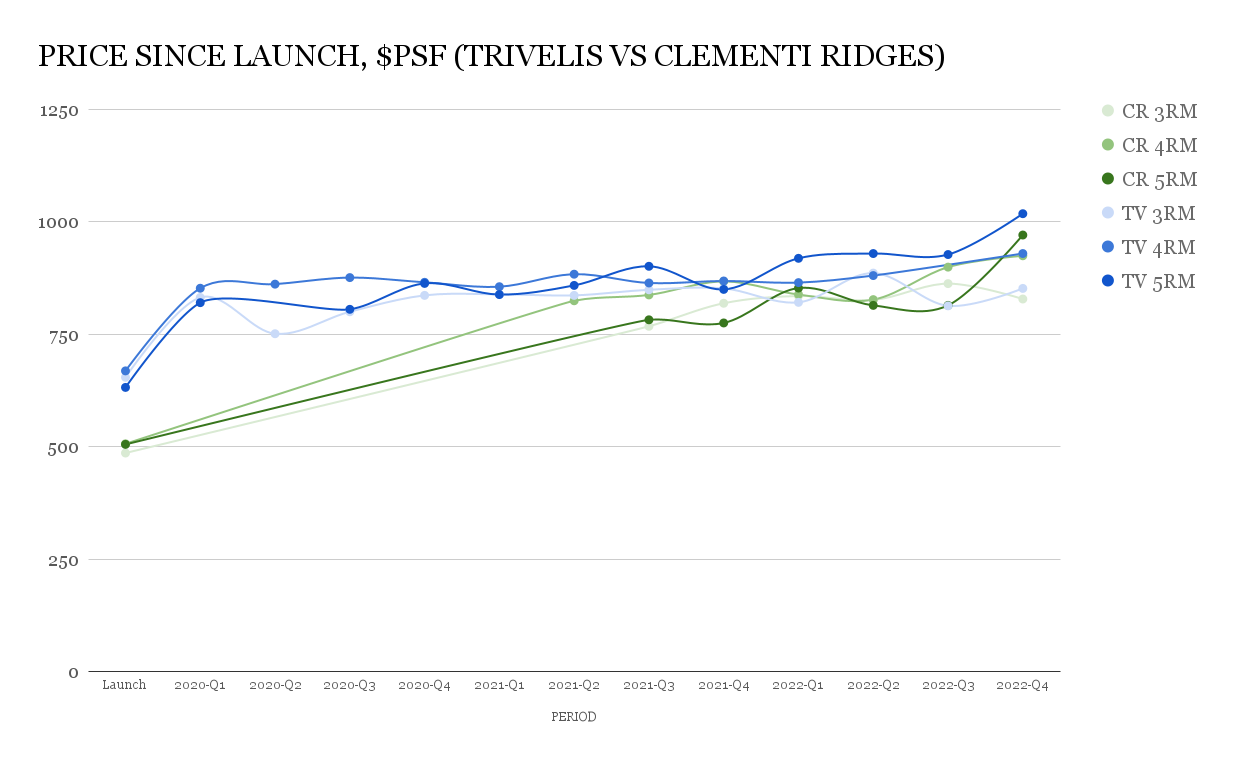
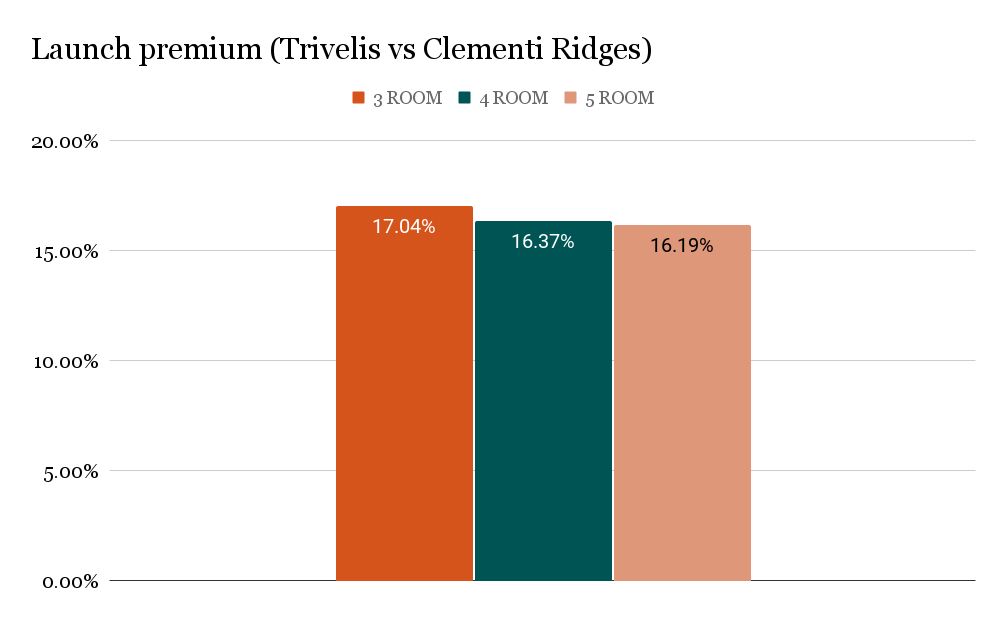
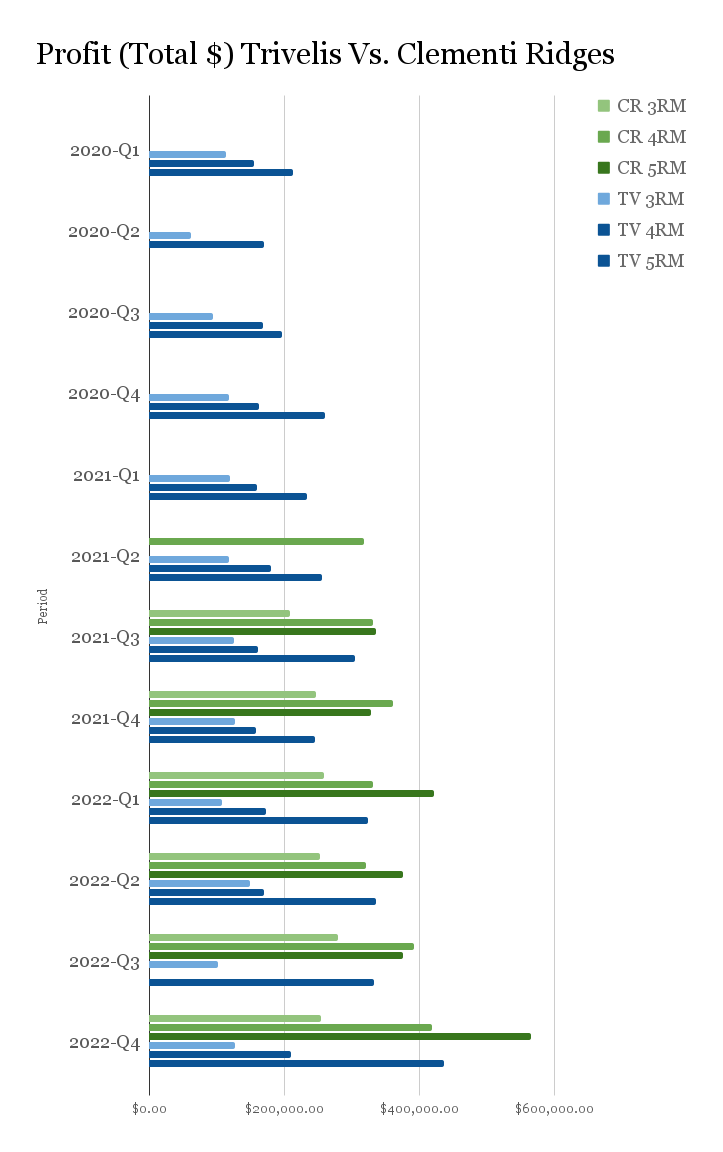
Notable details:
- Clementi Ridges had a head-start due to the much lower pricing
- Size probably worked to Clementi Ridges advantage
- 5-room flats make the difference
1. Clementi Ridges had a head-start due to the much lower pricing
In terms of overall quantum, a 4-room flat at Clementi Ridges was about $507,000 at launch, compared to $590,000 at Trivelis. A 5-room flat was $614,500 at Clementi Ridges, but $714,000 at Trivelis. Overall, Trivelis was about 16 to 17 per cent more expensive.
(There were news reports at the time that Clement Ridges cost 25 per cent less, but this is true only for price per square foot; see above).
It’s quite tough for Trivelis to compete under these circumstances: both properties were almost the same age with the same general location, and Clementi Ridges tended to have larger units.
Trivelis only had “better finishing” from private developers to count on; and it’s unlikely that alone could make up for a 16 per cent price gap; especially not when complaints about defects began to pour in.
More from Stacked
Here’s Where The Future MRT Stations May Be
These are some interesting - and well-researched - speculations on MRT lines that we may see in future. Some of…
As an aside, note that over time, Clementi Ridges also managed to close the price psf gap with Trivelis!
2. Size probably worked to Clementi Ridges advantage
HDB flat buyers are overwhelmingly family units. These buyers tend to prize space above many other concerns; you can see it in the constant complaints about how HDB flats have gotten smaller.
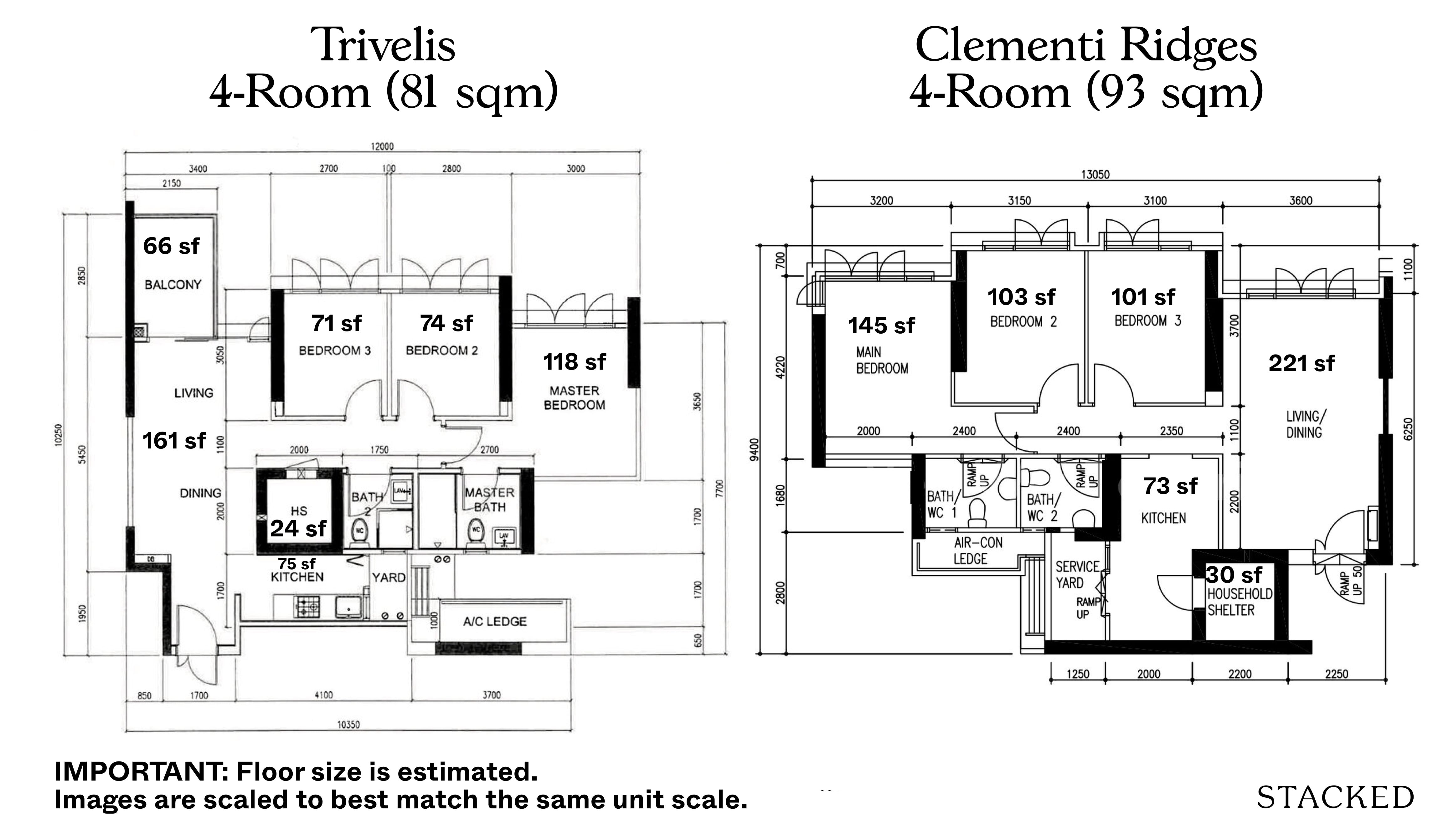
Along with the lower launch price, this might explain why Clementi Ridges ended up performing so much better on the resale market. From the numbers above, we can see transactions with 65 to 70 per cent profit for Clementi Ridges, while the typical profit for Trivelis is 27 to 40 per cent.
Overall, those who bought and sold Clementi Ridges would be making around twice as much as their Trivelis neighbours.
3. 5-room flats make the difference
The different sized units in Clementi Ridges see a comparable distribution of profits (as a percentage). But for Trivelis, the 5-room flat clearly beats out the 3 and 4-room counterparts. This is, again, likely related to size; and the 3 and 4-room units probably look small in contrast to the 5-room units.
Among the initial buyers at Trivelis, those who opted for the largest units have probably fared the best.
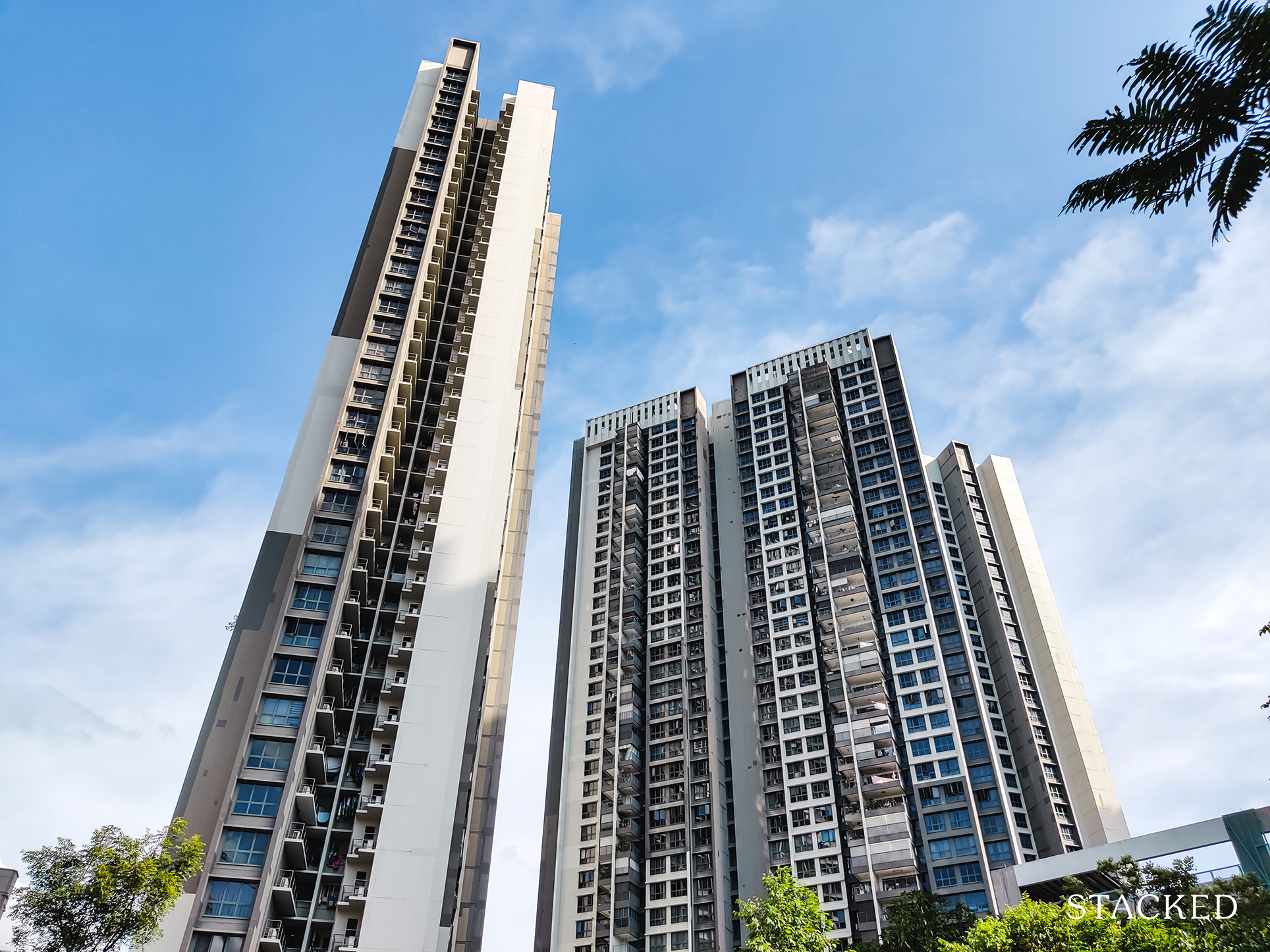
HDB ReviewsTrivelis Clementi DBSS Review: Convenience & Greenery But Small Living Spaces
by Reuben DhanarajA quick note on the defects
Some will definitely ask why we’re not bringing up the issue of defects, as there were several complaints about Trivelis; this even made it into the media.
This included:
- Defective stove knobs
- Rusty dish racks
- Poor quality laminate flooring
- Flooding along the corridor
- Scratched floor tiles
- Exposed sanitary pipes and water heater
We hesitate to do so because the phenomenon was not specific to Trivelis. Even the very last DBSS flat in the series, Pasir Ris One, ended up with complaints like its narrow corridors (an arguably worse problem than Trivelis, since it’s not fixable). Some of the DBSS flats that had complaints have subsequently done well. The Peak at Toa Payoh, for instance, saw numerous complaints at first; but even have been flats that have reached the million-dollar mark.
We can’t be certain that the defects haven’t, at this point, been sufficiently corrected or just accepted; perhaps to the point where they don’t impact price.
Two important takeaways from the Trivelis vs. Clementi Ridges situation
The first is that we need to pay attention to nearby land plots, before buying. If we can spot nearby plots for residential development, we need to consider the potential impact if they end up blocking the view, creating more traffic, or just making your property look like a poor alternative (in this case, by being both larger and cheaper).
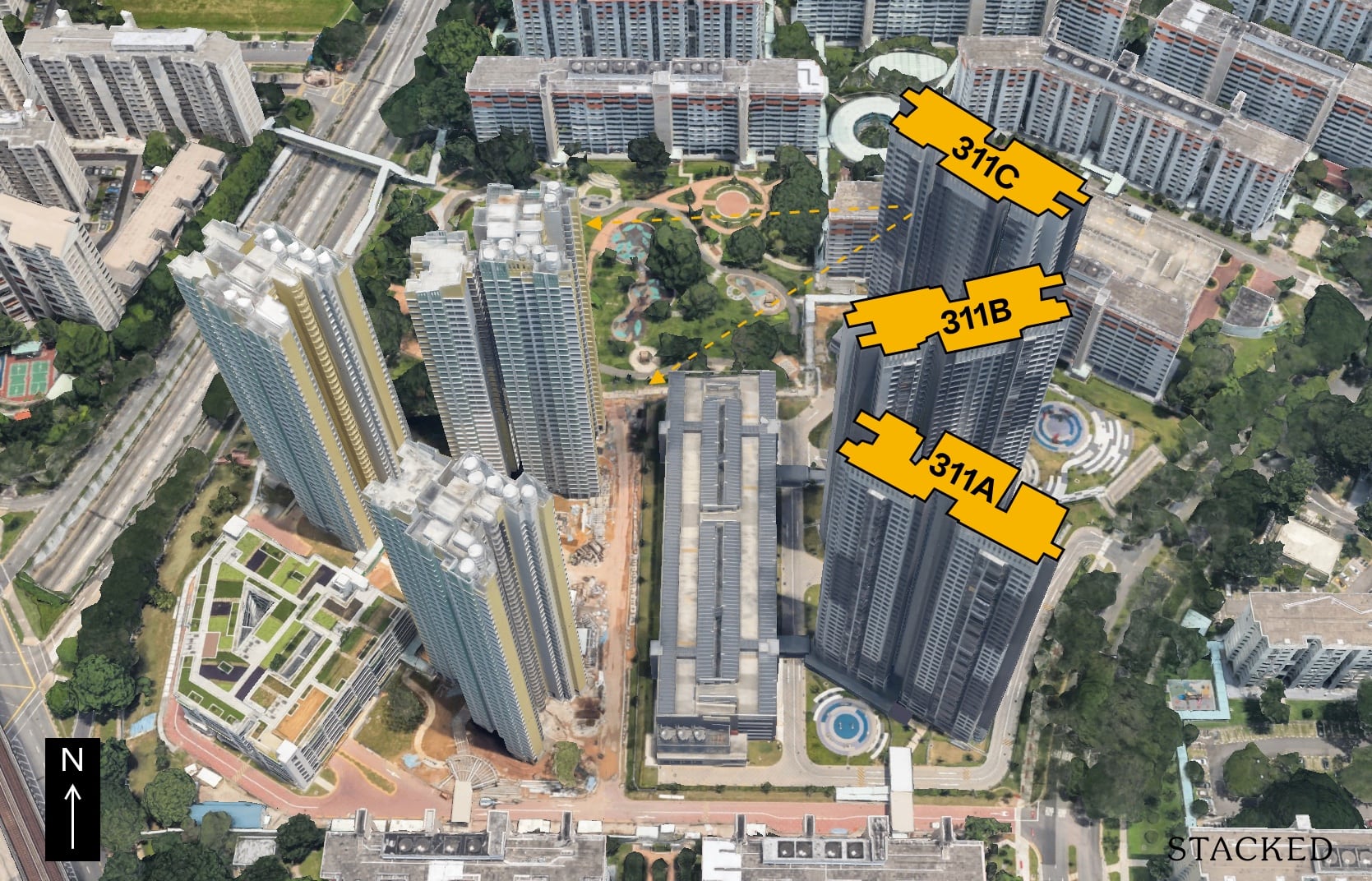
The second, which is perhaps more for the authorities, is that developers should be made to sell the units on their own – not under the auspices of a government agency.
Notice that ECs, for which developers need to build showflats and handle all the marketing, never got as many complaints as DBSS projects.
With DBSS, units were sold through HDB. This may have had the unintended effect of subjecting the projects to less scrutiny, as Singaporeans overwhelmingly trust HDB (while often overlooking the fact that HDB didn’t build their DBSS flats).
In any case, given the learnings and outcome from the DBSS projects, we are unlikely to see such a scheme again.
For more on the Singapore property market, follow us on Stacked. We’ll provide you with price movements and in-depth reviews, so you can make a better decision.
If you’d like to get in touch for a more in-depth consultation, you can do so here.
Ryan J. Ong
A seasoned content strategist with over 17 years in the real estate and financial journalism sectors, Ryan has built a reputation for transforming complex industry jargon into accessible knowledge. With a track record of writing and editing for leading financial platforms and publications, Ryan's expertise has been recognised across various media outlets. His role as a former content editor for 99.co and a co-host for CNA 938's Open House programme underscores his commitment to providing valuable insights into the property market.Read next from Property Market Commentary

Property Market Commentary When Renting In Singapore Is The Smarter Move — And Buying Can Wait

Property Market Commentary A Wave Of New HDB Resale Supply Is Coming In 2026: Here’s Where To Find Them

Property Market Commentary 5 Key Features Buyers Should Expect in 2026 New Launch Condos

Property Market Commentary What “Lucky” Singaporean Homebuyers Used To Get Away With — That You Can’t Today
Latest Posts

On The Market Here Are The Cheapest 4-Room HDB Flats in Central Singapore You Can Still Buy From $490K

Editor's Pick Should We Buy An Old 99-Year Leasehold Condo To Live In: Will It’s Value Fall When The Lease Runs Out?

Pro How A Once “Ulu” Condo Launched In 1997 Became A Top Performer

Editor's Pick I Reviewed A New Launch 4-Bedroom Penthouse At Beauty World

Editor's Pick Why Singaporean Families Are Looking At This Landed Enclave From Around $4M

Singapore Property News Lentor’s First Condo Is Complete — The Early Profits May Surprise You

Property Advice We Own A $800K 1-Bedder And A $1.1M 3-Bedder: Is It Possible To Upgrade To A 4-Bedder Condo?

On The Market These Are Some Of The Cheapest 5-Room HDB Flats Left In Central Singapore

Pro This 698-Unit Ang Mo Kio Condo Launched At The Wrong Time — And Still Outperformed Peers

Singapore Property News $281.2M in Singapore Shophouse Deals in 2H2025 — But That Number Doesn’t Tell the Full Story

Property Investment Insights These Resale Condos In Singapore Were The Top Performers In 2025 — And Not All Were Obvious Winners

Singapore Property News CapitaLand–UOL’s $1.5 Billion Hougang Central Bid May Put Future Prices Above $2,500 PSF

Singapore Property News Why New Condo Sales Fell 87% In November (And Why It’s Not a Red Flag)

Pro How A 944-Unit Mega-Condo In Pasir Ris Ended Up Beating The Market
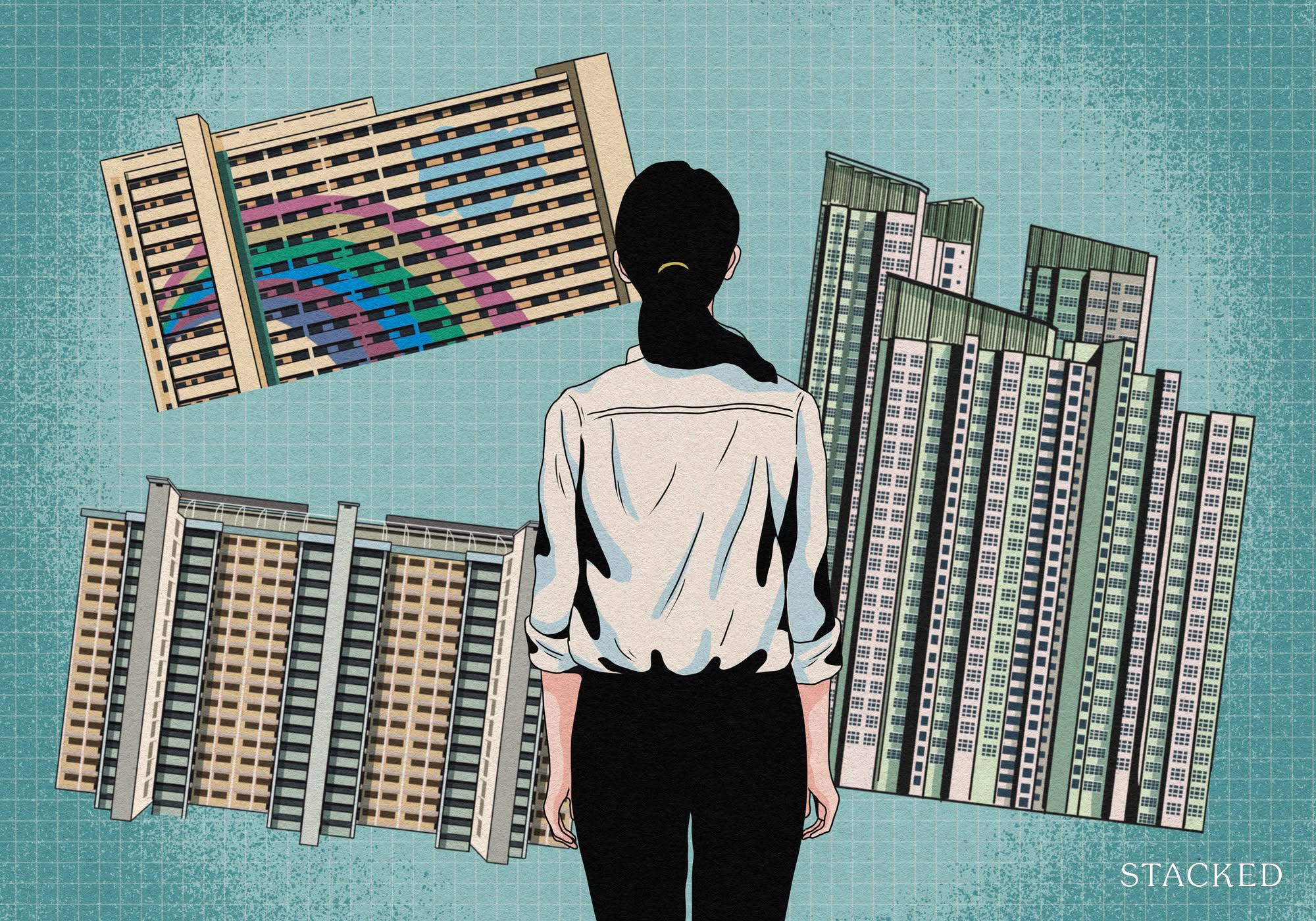
Property Investment Insights What Changed In Singapore’s Property Market In 2025 — And Why It Matters
